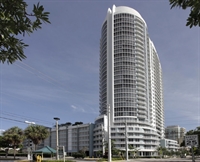Multifamily Assets Give South Florida Investors a 'Solid, Secure Feeling'
Multifamily Assets Give South Florida Investors a ‘Solid, Secure Feeling’

 |
Multifamily sales volume in South Florida for 2017 likely won’t reach the dizzying heights of a year ago, but brokers and analysts expect investor demand for rental properties to remain strong in 2018 and beyond.
As of early December, 709 sales in Palm Beach, Broward and Miami-Dade Counties totaled $4.25 billion, compared with 755 sales and $6.3 billion in 2016, according to CoStar data.
The dollar volume and number of transactions climbed steadily from 2013 through 2016. Year-to-date, the 2017 price per unit is $133,000. Its highest level in recent years was $143,000 in 2016.
Two of the more prominent apartment deals this year: the $133.55 million sale of Amaray Las Olas – the 254-unit luxury tower in downtown Fort Lauderdale (pictured, above), and the $59 million sale of the 221-unit building at 2001 Ludlam Rd. in West Miami.
South Florida’s multifamily sales dynamics are consistent with what’s happening at the national level, said Galina Alexeenko, a regional economist for CoStar Group, Inc. Transaction volume appears to have slowed in 2017 after peaking last year, though it’s unclear what the precise reason is, she said.
“I heard a few clients comment that a shortage of assets for sale may in-part be caused by investors’ reluctance to sell since it would be difficult to find attractive uses for sales proceeds,” Alexeenko said. “Some have suggested that while capital remains plentiful, a lack of assets for sale may be dampening the number of deals, making true price discovery difficult. However, cap rates have generally been on a downward trajectory nationally and in South Florida.”
Still, investors are encouraged by several factors that continue to fuel the rental market.
In a recent report on multifamily sales, Cushman & Wakefield’s Calum Weaver noted that household formations in the tri-county region are expected to grow by more than 50,000 a year in the next five years.
Conservatively projecting 40,000 a year, with 40 percent of those deciding to rent, would translate into 16,000 new renters a year in South Florida, according to Weaver.
While some analysts say developers need to be cautious about overbuilding, Weaver points out that rental construction was virtually non-existent in the region from 2003 to 2013 due to the Great Recession and the financial crisis.
“The supply of apartments needs to catch up,” he told CoStar News. “With the current supply, I would argue it hasn’t even caught up yet.”
Renting used to get a bad rap, but a quarterly housing index created by professors at Florida International University in Miami and Florida Atlantic University in Boca Raton shows that South Florida renters can build wealth as easily by renting as owning.
Buyers build equity, but renters can have just as big of a nest egg if they reinvest the money they would have spent on owning, such as insurance, taxes, maintenance and other costs, according to the index, which analyzes home prices, rental rates and investment streams in 23 major metropolitan areas nationwide.
“In the old days, there wasn’t easy access to stock and bond markets,” said Ken Johnson, an FAU professor and one of the creators of the Beracha, Hardin & Johnson Buy vs. Rent Index. “This concept of renting and reinvesting is becoming more popular. It’s not a sign of a weakening economy. It’s a sign that people are making a hard, thought-out decision.”
The push toward renting began during the housing bust from 2005 through 2011. Tens of thousands of people lost homes in the downturn, and many are still leery of re-entering the housing market, said Jack McCabe, an analyst in Deerfield Beach, FL.
“That left a bad taste in a lot of people’s mouths,” said McCabe.
As of the third quarter of 2017, the national homeownership rate was 63.9 percent, down from 68.8 percent in the third quarter of 2005, the peak of the housing boom, according to figures from the U.S. Census Bureau.
Former homeowners have turned renters by choice and have come to enjoy the flexibility that renting offers. Even those who want to buy again are dealing with poor credit and a difficulty in saving for a down payment, McCabe added.
Despite all the new apartment construction across the region, many buildings are leased at 94 percent and above, which is considered full occupancy, according to McCabe.
Rents, meanwhile have been rising quickly. Over the past five years, the average rental rates in Miami-Dade and Palm Beach Counties have increased by 26 percent, while Broward has seen a 27 percent jump during the same period, according to data from Reinhold P. Wolff Economic Research in Oakland Park, FL.
“All of these reasons are what give investors a solid, secure feeling,” McCabe said.
Source: Multifamily Assets Give South Florida Investors a ‘Solid, Secure Feeling’













